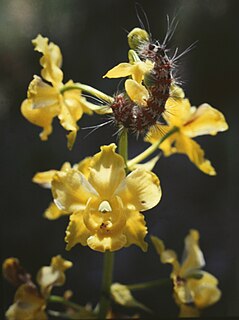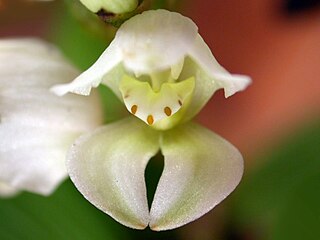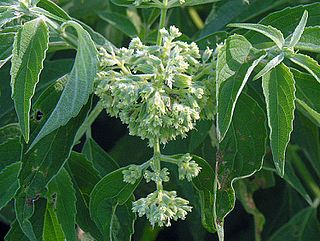The name Catuaba is used for the infusions of the bark of a number of trees native to Brazil. The most widely used barks are derived from the trees Trichilia catigua and Erythroxylum vaccinifolium. Other catuaba preparations use the bark of trees from the following genera or families: Anemopaegma, Ilex, Micropholis, Phyllanthus, Secondatia, Tetragastris and species from the Myrtaceae.

Aspidosperma polyneuron is a timber tree native to Brazil, Colombia, Peru, Argentina, and Paraguay. It is common in Atlantic Forest vegetation. In addition, it is useful for beekeeping.
Aspidosperma polyneuron is a timber tree native to Brazil. It is common in Atlantic Forest vegetation. In addition, it is useful for beekeeping.

Aechmea bromeliifolia is a bromeliad native to southern Mexico, Central America, Trinidad, and South America as far south as northern Argentina.

Aechmea nudicaulis is a bromeliad species in the genus Aechmea, which is often used as an ornamental plant. This species is native to Central America, the West Indies, central and southern Mexico, and northern and central South America.

Hypoxis decumbens is a species of plant in the Hypoxidaceae, considered by some authors to be included within the Liliaceae or Amaryllidaceae. The species is widespread across South America, Central America, Mexico, and the West Indies.

Oxypetalum is a genus of flowering plants in the family Apocynaceae, first described with this name in 1810. The genus is native to South America.
Thoracocarpus is a genus of plants first described as a genus in 1958. It contains only one known species, Thoracocarpus bissectus a hemiepiphytic vine. It is native to Costa Rica, Panama, Cuba, Trinidad & Tobago, and South America.

Cyrtopodium cristatum is a species of orchid native to South America.

Eulophia alta is a species of orchid, known as the wild coco. It is widespread across tropical and subtropical parts of Africa, South America, Central America, Mexico and the West Indies, as well as the southeastern United States.

Govenia utriculata is a species of orchid. It is widespread across much of Latin America and the West Indies, from Mexico and Puerto Rico south to Argentina.

Tillandsia balbisiana, common name northern needleleaf, is a species of bromeliad in the genus Tillandsia. This species in native to Mexico, Central America, Colombia, Venezuela, the West Indies, and Florida.

Guzmania monostachia is an epiphytic species in the genus Guzmania. Also known as a West Indian tufted airplant, this species is native to South America, Central America, the West Indies and Florida. The species is also reportedly naturalized in Hawaii.
Tillandsia polystachia is a species in the genus Tillandsia. This species is native to Central America, the West Indies, Bolivia, Colombia, Brazil, Ecuador, Mexico and Venezuela.

Thelyschista is a monotypic genus of flowering plants from the orchid family, Orchidaceae. The sole species is Thelyschista ghillanyi, endemic to the Bahia region of Brazil.
Euterpe catinga is a palm species in the genus Euterpe. It is found in forests of a dry, sandy soil and very peculiar vegetation, known as catinga forests in northern South America.

Hoslundia is a genus of flowering plant in the family Lamiaceae, first described in 1804. It contains only one known species, Hoslundia opposita. It is widespread across much of sub-Saharan Africa including Madagascar.
Secondatia is a genus of plants in the family Apocynaceae first described as a genus in 1844. It is native to Jamaica and South America.

Ribes magellanicum is a South American species of shrubs in the currant family, found in Patagonia.
Chromolaena ivifolia called ivy-leaf false thoroughwort, or ivyleaf thoroughwort, is an American species of flowering shrub in the sunflower family. It is native to North America and South America, from the southeastern United States to Argentina. Within the United States, the species is found in eastern Texas, Louisiana, southern Mississippi, southern Alabama, and Florida.













